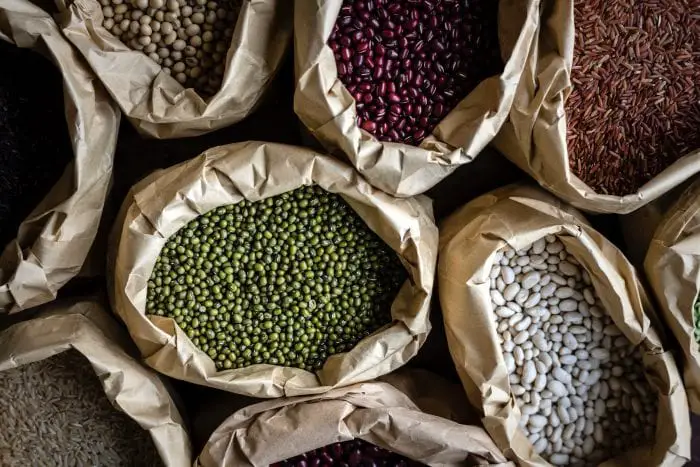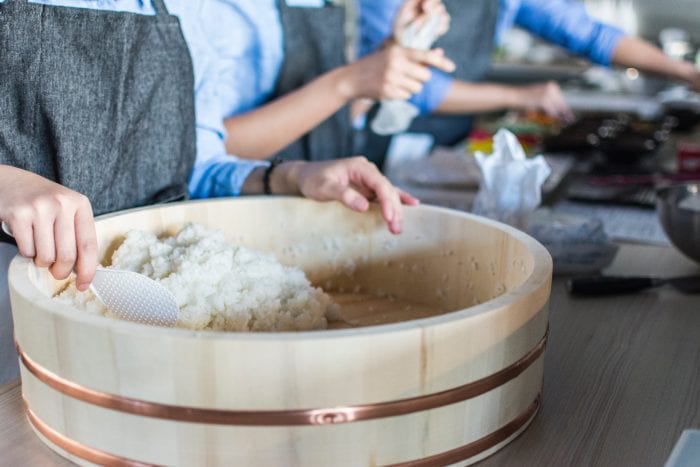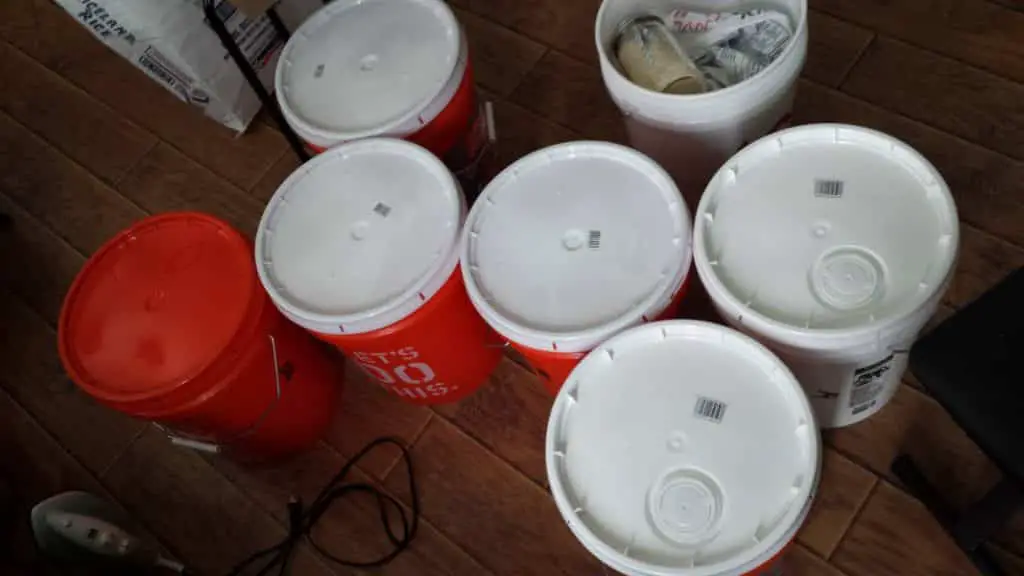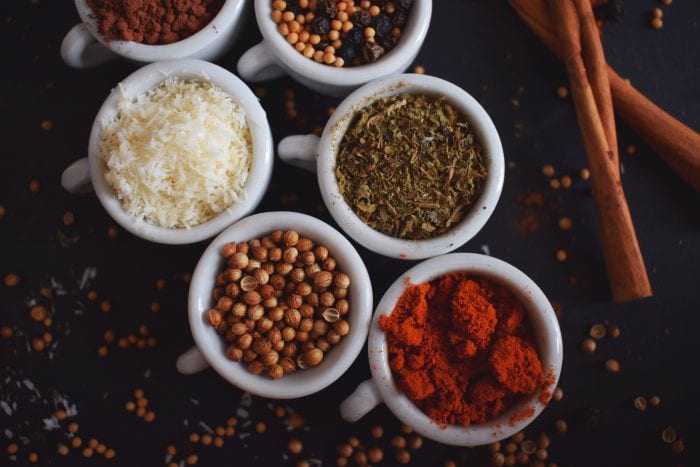How much does it really cost to put away some home packed storage foods? What is the cost of 5 gallons of beans or rice?
We all know that picking up some buckets of beans and rice is a wise investment, but what is the breakdown of cost?

I bought 100 lbs of rice and 100 lbs of beans to put together some food buckets for gifts and for staging at strategic locations.
This gave me a good breakdown of the cost for someone assembling food buckets today.
The Beans, Rice, and Packing Supplies
These prices include the Maryland sales tax of 6%.
| Rice (50 lbs. x 2) | $49.98 | $24.99/50 lbs. |
| Pinto Beans (100lbs) | $349.00 | $3.49/lb. |
| 6 Buckets (5 gallon) | $59.95 | $9.99/bucket |
| 6 Bucket Lids | $65.70 | $10.95/lid |
| 10 Mylar Bags & 10 Oxygen Absorbers (10 pack bundle) | $20.99 | $2.09/1 Mylar Bag + 1 Oxygen Absorber |
| Total | $545.62 |
Bean Bucket
100lbs of beans equated to 3 full buckets and about 4 lbs leftover. That’s roughly 32 lbs of beans per bucket.
| 30lbs of Beans | $104.70 |
| 5-gallon Bucket | $9.99 |
| 5-gallon Bucket Lid | $10.95 |
| 1 Mylar Bag + 1 Oxygen Absorber | $2.09 |
| Total | $127.73 |
Rice Bucket
100lbs of rice equated to 3 full buckets and about 1 lbs leftover. That’s roughly 33 lbs of rice per bucket.
| 33lbs of Rice | $16.49 |
| 5-gallon Bucket | $9.99 |
| 5-gallon Bucket Lid | $10.95 |
| 1 Mylar Bag + 1 Oxygen Absorber | $2.09 |
| Total | $39.52 |
The Cost
One 5 gallon bucket of beans and a one-gallon bucket of rice together total $167.25 and give me about 65lbs of food (10 gallons). These foods, especially rice, will absorb water when cooked and will provide much more than 65lbs of food.
Tips:
- Save a few bucks and avoid the fancy Mylar bag sealers, use your clothes iron and a bar of metal (like an old steel level) to seal your Mylar bags.
- After you seal the bucket, splash some house paint on the outside of the bucket and lid to make it appear to be a bucket of paint! Starving people rarely steal a bucket of paint! Even better, make your top buckets in your stacks a real partial bucket of paint!
What Makes Rice and Beans Good Survival Foods?
Now that you are aware of how much it usually costs to make a bucket each of rice and beans to store as your survival foods when disasters or emergencies strike, it is time to find out whether this combination of foods is truly worthwhile to prepare. Here are just some reasons why packing rice and beans and making them a part of your survival foods should be on top of your priorities:
- Rich in Carbs and Nutrients

What is so great about rice and beans is that they are rich in nutrients. Both also contain dense carbs that serve as great sources of energy. This is essential when you need to survive during a disaster or emergency. Take note that you need filling foods during these survival situations and beans and rice can fulfill that purpose because they can supply you with adequate energy.
Furthermore, both these survival foods are rich in protein, allowing you to make a full protein meal from it. They can increase your energy for a long time, make you feel full for longer, and lower your risk of experiencing a crash. With the kind of energy these foods offer, you will have a better chance of surviving any disaster.
Both rice and beans also contain enough iron. They can also provide your body with the amino acids it can’t make on its own during emergencies.
- Long Shelf-life

Of course, rice and beans make for excellent survival foods because of their long shelf-life. You can even expect them to last for 6 months to several years. Just make sure that you store them properly so you can expect them to last for as long as possible. When it comes to storing rice, one thing to take note of is that it tends to expand up to 4 times its exact volume once you cook it. With that in mind, avoid storing too much of it in your survival bag.
A wise tip is to save around one to three cups daily based on your survival objectives. Also, take note that a cup of uncooked rice provides around 600 calories. That said, you might need around 3 cups of it if you wish to survive 24 hours by just eating rice.
- Easy to Cook

Another reason why rice and beans make a good combination of survival food is that they are easy to cook and versatile. You can prepare delicious, easy, healthy, and cheap recipes out of it. You can make it as the main entrée or side dish. Furthermore, you can pair it up with any kind of protein so you can prepare a complete meal.
Tips on Making the Most Out of Rice and Beans for Survival
Do you want to make sure that you can survive whatever disaster or emergency attacks you with rice and beans alone? Then make the most out of this survival food combination through these tips:
- Get used to eating rice and beans – If you want to take advantage of these survival foods, then make sure that you and your family can eat them during an emergency. Try them in your daily cooking first. Avoid buying in bulk and storing too much of them if you are not used to eating them yet. Note that the most basic prepping principle is to buy and store only those that you can eat.
- Store seasonings, too – Your survival bag should also contain a few seasonings. These are essential when adding taste and flavor to dried pinto beans and rice. If you have plain rice then one way to flavor it is to add dried nuts or fruits. Another way to flavor it is to use chicken, beef, or vegetable broth in place of water. Cooking rice with coconut milk can also add flavor to it while speeding up the process of its preparation.
- Store them properly – Avoid committing the mistake of storing dried beans and rice in the specific bags and packs they came in. It is because doing so might only make it prone to vermin. A wise tip is to buy these survival foods in bulk then store them in food bucket containers, such as the ones I taught you earlier. Learn using mylar bags that have oxygen absorbers as a means of storing beans and rice, too.
Conclusion
Overall, because of their ease of storage, long shelf-life, high nutrition profile, and ease of cooking and preparation, rice and beans should be prioritized when you are trying to build your survival stores. You have a much better chance of surviving any disaster for a few days with both these foods around.




I was wondering where you bought a food grade bucket for $3.15 …. then I saw the paint buckets …. question answered
Yeah, I used food grade Mylar inside those buckets. I prefer white, Food-grade buckets, but for this round, I felt some rudimentary camouflage couldn’t hurt.
can you use reg plastic buckets if you use mylar bags
Why not get food grade buckets from restaraunts which you can more often than not get FREE then you can possibly not use the mylar bags saving more money. Most restaraunts will have extra and just give them to you for the asking.
If you live around a Firehouse Subs, they sell their empty pickle buckets – 5 gallon, food grade with lid – for $2 and the money goes to charity.
Check your local LDS store. They sell to the general public too. I get #10 cans for about 82 cents a pound for black beans, pinto are 90 cents a pound and white beans are 80 cents a pound.
Lowes has food grade buckets for $4.50 and lids for $2. A little more, but at least the pails are food grade. I also saw a blog where a guy took one pound portions of rice, put them in new nylon stockings, then filled the rest of the mylar bag with beans. That way, you only have to open 1 mylar bag at a time to get equal quantities of both rice and beans. Of course I didn;t see this till AFTER I had packed 20 pails of rice and beans in separate pails.
Pinto Beans $91.90 $0.06/ounce @ 100 that would only be $60 an ounce.
That would be true if we were discussing 100 ounces, but we are talking about 100 pounds (16oz/pound).
((91.90/100)/16)=0.057
I am able to land 7 pound bags of rice at our local grocery store for a few bucks. It goes on sale all the time.
Just need to shop around you can find some decent bargains on eBay
I seal Mylar bags with my gf’s hair tongs. Works great
Based on a 2,000 calorie per day diet. How long would this amount of rice and beans last 2 people???
I got 31 gal galvanized trash cans with lids from Home Depot for $25. Then I filled them with mylar bags. Mice can eat through plastic but this is safe from most critters, except racoons.
I have been living this way for decades. No need for the mylar if you eat through it consistently. Gamma lids are worth every penny for easy sealing and opening of buckets. I use dry ice to push out oxygen when I seal up my wheat, fast and easy. Beans become very, very hard to cook when they get old and I got some stored wheat from a neighbor that was decades old and it was terrible. Just because you can eat something, does not mean you want to. Rotate your storage and eat it, you will be happier and save money.